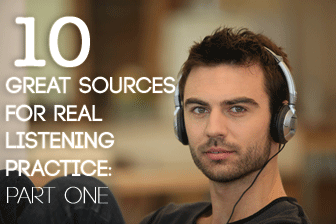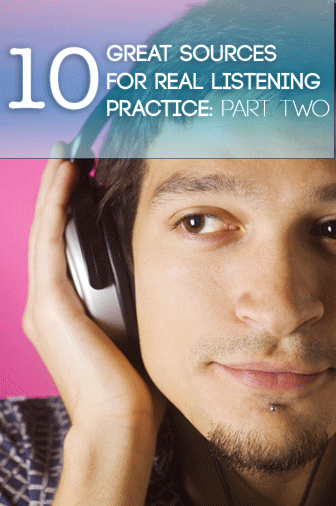10 Great Sources for Real Listening Practice: Part One


As teachers, sometimes we do not know where to start when it comes to listening materials, and for students the challenge is in understanding what they hear. 10 Great Sources for Real Listening Practice: Part One gave six materials you can use in your classroom to teach listening practice. They started with less challenging materials for beginning and intermediate students. Part Two continues with five even more challenging materials to use for practicing aural skills.

A video-recorded lecture is one step up in difficulty from radio material. Many schools and libraries have these materials available to check out at no cost to you. You can also find instructional videos online quite easily. Though your students will have visual input if you use a lecture as a listening exercise, the speaker’s use of English will be far more natural than the language you would use in a lecture. In addition, your students will not be able to ask clarifying questions, which will add to the challenge. Try following the listening exercise with a short true/false quiz on the material the professor presented, and then put your students in groups to discuss their answers. Challenge them to recall what the person said that made them answer as they did.
Now that your students are getting quite proficient at listening, try a recorded book for a listening exercise. Of course, you will want to take a short selection for students who have less experience and proficiency in English, but advanced students should be able to listen to material in segments of at least fifteen minutes. An audio book takes away the visual that the recorded lecture provided but uses more careful pronunciation and speaking rhythm. That does not mean that it will be easy for your students. Audio books often use different accents for different characters, and that may present quite a challenge to your students. For a less challenging activity, play a part of a book you are reading as a class. For something more challenging, play something your students are not familiar with. You can then follow the listening activity by asking for a summary of what the speaker said or for predictions as to what will happen next in the story.
Real people using real language is a real challenge for nonnative speakers. The time has finally brought us to YouTube videos. You can find a video for just about anything you are looking for: instructions on how to play the guitar, funny things that kids say, cooking programs, social interactions…the possibilities are almost endless. The challenge is that these are real people, not actors clearly delivering a line. They have real, and sometimes ungrammatical, speech patterns. They speak with accents and at a higher rate than your students are probably used to hearing. This material will not be easy for your students. With that said, be sure to warn them! You do not want them to be overly intimidated or have too high expectations, so much so that they feel like giving up after they listen to cousin Jake explain how he modified the motor in his ATV. Whatever segment you choose, you will need to play it for your students more than one time, and start your follow up by asking just how much they were able to understand. Review any unfamiliar vocabulary and play it again. Then give your students some comprehension questions and play the video yet a third time. Encourage your students that if they are successful with this type of listening material, they should be very proud of their language skills!
Very similar to the YouTube video but without the visual input, a recorded conversation between two or more people will be the ultimate challenge for your students. Take note, this is not a scripted conversation between people who know they are being recorded, the type that may come along with your grammar or listening textbook. To give your students this type of listening material, you will have to do one of two things. The first option is to ask some friends to let you record them for your class and then edit out the first part of the conversation. If they know they are being recorded they will most likely start their conversation carefully with unnatural speech patterns. Edit this section out to get to the challenging material that will surface when they are no longer paying close attention to their speech. The second option for this type of material is to record strangers in a public place having a conversation. The first option will give you a better recording but chance that the speech will not be completely natural. The second will ensure that your students are exposed to real, authentic speech, which will be challenging to listen to, but the quality of your recording may suffer. This type of listening exercise would work well with a cloze exercise – transcribe the conversation and remove every fifth word, and then challenge your students to fill in the blanks as they listen. It won’t be easy since natural speech flows together, not clearly separating one word from the other, so your students will have to listen carefully. Give them a chance to listen to the whole thing first and then present the cloze the second time they listen. They will not have any video input to assist their comprehension, so this will be the ultimate challenge for your ESL students!
As a bonus, do not forget the great benefit that conversation partners offer your students. If you are able to recruit volunteers who are native speakers to simply come and talk with your students from time to time, their listening abilities will improve. This requires no lesson plans, though you can give some discussion questions to stimulate discussion if necessary, and no special materials. Many native English speakers will be willing to be a conversation partner for the social benefit or the exposure to individuals from foreign lands.
You can use any of the follow up activities with almost any of the listening activities, so if you find an exercise that your students like and from which they benefit, by all means do it. If teaching listening were easy, your students would come to their English programs with more proficiency in the subject. You can help them improve no matter where they are on the scale now. Try some of these activities and those in 10 Great Sources for Real Listening Practice: Part One and expect great things from your students!